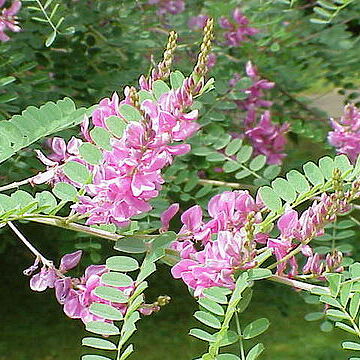Herbs or shrubs; more or less strigose with pale appressed hairs attached by their centers, these hairs often lending a gray green appearance to the plant. Leaves imparipinnate or pinnately or digitately 3-foliolate, less commonly simple; usually short-petioled; leaflets entire, venation, except for the midvein, obscure; stipels present, often inconspicuous; stipules setaceous, deciduous, apparently slightly adnate to the petioles. Inflorescence of axillary racemes or spikes, often dense, pedicels short or apparently absent, the flowers single in the axil of a caducous bract, the bracteoles absent. Flowers usually reddish or white, the hypanthium campanulate, the 5 calyx lobes subequal, corolla more or less pu-bescent outside, the standard broad, circular, subsessile, strigose outside, the wing petals oblong, somewhat adherent to the keel, auriculate, the keel petals coherent, laterally spurred; stamens 10, diadelphous, the vexillary stamen free, the sheath slender, the anthers with an apical projection; ovary slender, sessile, few to many ovulate, usually strigose, the style short, bent upward, glabrous, the stigma capitate. Fruits oblong or linear, rarely globose, curved or straight, usually terete or 4-angled, not usually compressed, dehiscent or apparently indehiscent, septate between the seeds; seeds globose to cylindric and truncate, compressed or 4-angled, attached at the middle.
Shrubs, shrublets, perennial herbs, or rarely annual herbs or small trees; trichomes typically medifixed (T-shaped), equally to very unequally 2-branched and sometimes crisped, or rarely simple multicellular hairs present with glandular tips. Stipules persistent or caducous. Leaves usually imparipinnate but for some species simple or reduced to 1 leaflet; stipels present or absent; leaflet blades usually opposite but sometimes subopposite or alternate, rarely with glands, margin entire. Racemes axillary; bracts usually caducous. Calyx campanulate or cup-shaped; teeth 5, subequal or abaxial one longer. Corolla usually reddish, sometimes white or yellow; standard usually covered outside with appressed trichomes but occasionally glabrous, base shortly clawed, apex usually obtuse to emarginate and mucronate; wings narrow, base auricled; keel falcate or spatulate, with spur adnate to wings. Stamens 10, diadelphous, only vexillary one free; anthers uniform, basifixed or subbasifixed, sometimes both ends hairy, apex apiculate; pollen 3-colporate. Ovary sessile, with 1 to many ovules; style linear, usually glabrous; stigma capitate. Legume linear, oblong, or ovoid, cylindric or 4-sided in cross section, 2-valved, septate, dehiscent; endocarp often spotted with tannin deposits. Seeds globose to rectangular; hilum small; cotyledons unequal; radicle oblique.
Perennial shrubs or subshrubs, sometimes arising from an underground rootstock; rarely annuals. Indumentum typically of 2-armed, sometimes with multicellular and/or gland-tipped hairs as well. Leaves simple, unifoliolate, trifoliolate or pinnate, discolorous; stipellae present in some species, persistent. Stipules present, sometimes spinescent and persistent. Inflorescence a pedunculate axillary raceme; flowers pedicellate; bracts usually deciduous, occasionally persistent. Calyx lobes 5, subequal or the lowermost longer; sinus between upper lobes v-to u-shaped. Corolla red or pink to purple; standard hairy on adaxial surface, base abruptly tapering to the claw; wings variously hairy; keel hairy at apex and upper margin fringed, lateral pockets spur-like. Stamens 10, 9 filaments connate and 1 free; filaments alternating long and short; anthers apiculate, glabrous or with tufts of hairs at the apex and/or the base. Ovary sessile, usually pubescent; ovules 1, 2 or numerous. Style longer, or sometimes shorter, than the ovary, incurved; stigma capitate. Pod straight or curved, spreading to descending, rarely ascending, usually linear and terete, sometimes angular, rarely globose or flattened, usually dehiscent; endocarp very often spotted. Seeds globose to cylindrical or cuboidal, separated by papery or pithy outgrowths of the endocarp.

